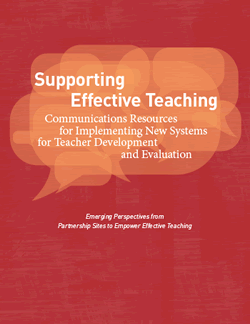-
Lesson 10: Engage the Media at the Right Time
External media relations has been less of a priority for most of the sites, at least in the early stages of their work, because the focus has been on internal communications to principals and teachers. The rationale: If districts and unions do their jobs well internally, these issues are less likely to “blow up on the front page.”
However, as the new evaluation systems begin to be implemented, additional public scrutiny is inevitable. The advice for working with the media on this issue does not differ from other issues:
- Have a plan.
- Be prepared.
- Be transparent and proactive.
- Build relationships.
- Use multiple messengers.
Examples from the Field:
Tulsa Public Schools
The school district had a comprehensive strategy for communicating publicly about the new “value-added” system that is so central to its new way of assessing the effectiveness of both schools and teachers. A detailed media plan spelled out the key steps, including giving an advance to the Tulsa World, training all media how to read the new reports, and providing key messages to district administrators. Several pieces, including an overview, translated the methodology of the new report cards. The district also was quick to publicize its positive news in April 2012, when nearly all of the state’s 520 school districts selected Tulsa’s model for their new teacher evaluation systems.
that is so central to its new way of assessing the effectiveness of both schools and teachers. A detailed media plan spelled out the key steps, including giving an advance to the Tulsa World, training all media how to read the new reports, and providing key messages to district administrators. Several pieces, including an overview, translated the methodology of the new report cards. The district also was quick to publicize its positive news in April 2012, when nearly all of the state’s 520 school districts selected Tulsa’s model for their new teacher evaluation systems.
Pittsburgh Public SchoolsMedia relations assumed a new urgency when multimillion-dollar budget cuts forced the school district to lay off hundreds of teachers in spring 2012; the local union wanted to base layoffs solely on seniority. The key advice from Communications Coordinator Susan Chersky:
- Be transparent and proactive. Pittsburgh began preparing teachers and the public a few months in advance that budget cuts at the state level would lead to staff reductions. The district explained the budget situation, made sure information for each staff member was accurate, and regularly updated the media and staff with detailed information.
- Communicate directly to teachers. The district used Constant Contact emails to regularly update teachers about what to expect and when because it did not want staff to be reading about developments in the newspapers without first hearing from the district.
- Have consistent messaging and multiple messengers. A priority was to make sure the public understood that layoffs by seniority was not the district’s preferred solution. The district relied on third parties such as A+ Schools, local foundations, and community leaders to help spread the word and publicly reinforce its position.
A+ Schools was particularly active and effective in generating community attention through media outreach, op-ed placements, letters to the editor, school board testimony, a public rally, and more than 1,500 postcards to the district and union in support of the district’s position.
"The outpouring of public demand over the past few months demonstrates that parents, students, and community members support the teaching effectiveness work and expect the district and union to make sure our best teachers are teaching our kids — regardless of budget constraints or contract language."— Carey Harris (A+ Schools)Memphis City Schools
When Clergy United for the Memphis Schools, organized by the Council for a Strong America, released its report on the importance of teachers, it created a multiday “echo chamber” of coverage, tapping several unusual suspects as public messengers. Two pastors and a rabbi helped release the study at a well-attended press conference that was covered by the Memphis Commercial Appeal (several articles) and all the local TV stations and weeklies. A follow-up Sunday Celebration of Teachers at local churches and synagogues drew additional coverage. Then, the local district attorney and police chief wrote letters to the editor. And statewide, two four-star generals wrote a supportive op-ed in the Nashville Tennessean."We deliberately wanted a lot of echoing on this issue."— Jeff Kirsch (Council for a Strong America) - Have a plan.



